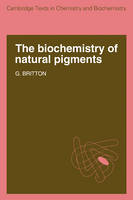
The Biochemistry of Natural Pigments
Seiten
2009
Cambridge University Press (Verlag)
978-0-521-10531-6 (ISBN)
Cambridge University Press (Verlag)
978-0-521-10531-6 (ISBN)
In the natural world colour is obvious and its importance in advertising the presence of flowers to pollinators and in camouflage is well known. This book describes the structures and properties of the main groups of natural pigments, their distribution in Nature, their biosynthesis and functions and their associated chemistry and biology.
In the natural world colour is obvious and its importance in advertising the presence of flowers to pollinators and in camouflage is well known. In most cases the property of colour is due to the presence in the tissues of natural pigments. But these pigments are of much greater importance than merely to give colour, e.g. the fundamental light-harvesting molecules of photosynthesis, the light-detecting molecules of vision and haemoglobin in the blood. This book describes the structures and properties of the main groups of natural pigments, their distribution in Nature, their biosynthesis and functions and their associated chemistry and biology. Industrial applications, and medical significance and uses, of certain groups of pigments are outlined and some ecological aspects of colour and pigmentation are touched upon. The book was written as a textbook for advanced undergraduates and graduate students and concentrates on the main features of each class of pigments and on general principles.
In the natural world colour is obvious and its importance in advertising the presence of flowers to pollinators and in camouflage is well known. In most cases the property of colour is due to the presence in the tissues of natural pigments. But these pigments are of much greater importance than merely to give colour, e.g. the fundamental light-harvesting molecules of photosynthesis, the light-detecting molecules of vision and haemoglobin in the blood. This book describes the structures and properties of the main groups of natural pigments, their distribution in Nature, their biosynthesis and functions and their associated chemistry and biology. Industrial applications, and medical significance and uses, of certain groups of pigments are outlined and some ecological aspects of colour and pigmentation are touched upon. The book was written as a textbook for advanced undergraduates and graduate students and concentrates on the main features of each class of pigments and on general principles.
Preface; Part I. Chemical and biochemical aspects: 1. Light and colour; 2. Carotenoids; 3. Quinones; 4. O-Heterocyclic pigments - the flavonoids; 5. Tetrapyrroles; 6. Other non-polymeric N-heterocyclic pigments; 7. Melanins; Part II. Functional Aspects: 8. The importance of colour in Nature; 9. Pigments in vision; 10. Photosynthesis; 11. Other photofunctions of natural pigments; Problems; Answers; Index.
| Erscheint lt. Verlag | 19.3.2009 |
|---|---|
| Reihe/Serie | Cambridge Texts in Chemistry and Biochemistry |
| Zusatzinfo | Worked examples or Exercises |
| Verlagsort | Cambridge |
| Sprache | englisch |
| Maße | 152 x 229 mm |
| Gewicht | 560 g |
| Themenwelt | Naturwissenschaften ► Biologie ► Biochemie |
| Naturwissenschaften ► Biologie ► Zoologie | |
| ISBN-10 | 0-521-10531-5 / 0521105315 |
| ISBN-13 | 978-0-521-10531-6 / 9780521105316 |
| Zustand | Neuware |
| Haben Sie eine Frage zum Produkt? |
Mehr entdecken
aus dem Bereich
aus dem Bereich


